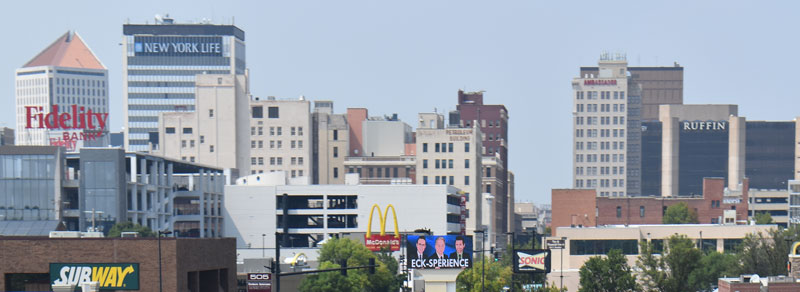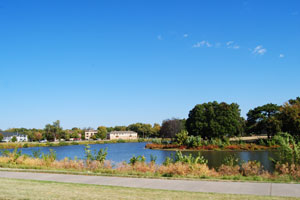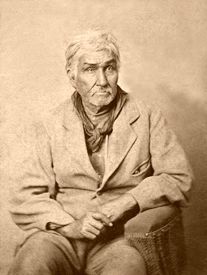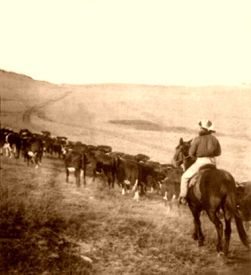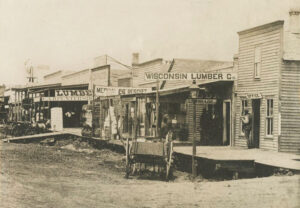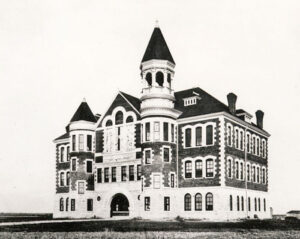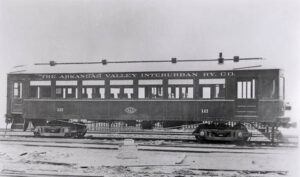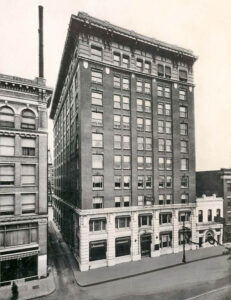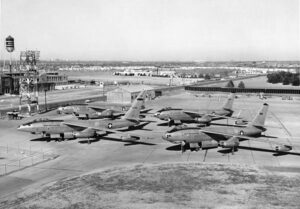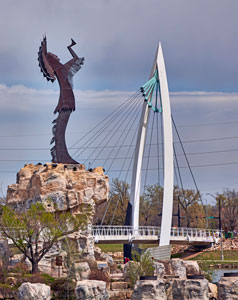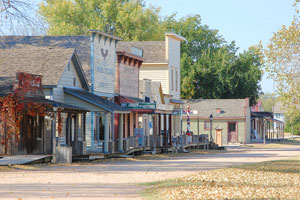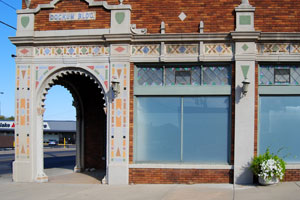Wichita, Kansas, is the largest city in the state and the county seat of Sedgwick County. As of the 2020 census, its population was 397,532.
It is located in south-central Kansas on the Arkansas River, about 140 miles southwest of Topeka, Kansas, 150 miles west of the Missouri state line, and 50 miles north of Oklahoma.
The site of Wichita was first settled in 1864 when J.R. Mead opened a trading post. When Mead first settled, the Wichita Indians occupied the land, and the town was named for the tribe. The word means “Scattered Lodges.”
The Wichita Town Company was organized by Governor S. J. Crawford, W. W. H. Lawrence, J. R. Mead, E. P. Bancroft, A. F. Horner, and I. S. Munger. Surveyor Darius Munger built a log structure for the company to serve as a hotel, community center, and post office. Milo B. Kellogg, manager of Durfee’s Ranch, was the postmaster.
In 1865, a townsite was platted, and more people moved in.
A short-lived army post known as Camp Beecher was established nearby on July 9, 1868, with Colonel Barr in command of the militia stationed there. He also became the first postmaster. However, the camp was abandoned the following year.
In 1869, Jesse Chisholm pioneered the Chisholm Trail, and trade quickly developed in the area.
The first school was held in an army dugout in the winter of 1869-70.
In 1870, Mr. Munger opened a hotel and F. A. Sowers started the Wichita Vidette newspaper. The first financial institution was the Arkansas Valley Bank, started in 1870 by W. C. Woodman.
Wichita was formally incorporated as a city on July 21, 1870.
A $5,000 schoolhouse was built in 1871.
In 1871, Wichita was incorporated as a third-class city. At the election, 156 votes were polled, and the following officers were elected: Mayor, E. B. Allen; attorney, D. C. Hackett; police judge, H. E. Vantrees; clerk, O. W. Brownwell; treasurer, N. A. English; marshal, M. Meagher; councilmen, W. B. Hutchinson, S. C. Johnson, C. Schattner, George Schlichter, A. H. Fabrique, and George Vantillburg. The following year, with a sufficient population, the form of government was changed to that of a second-class city.
Before the railroad was completed, there was bitter rivalry between Wichita and Park City, which stood 14 miles to the northwest on the Arkansas River. An attempt was made to divert the cattle trade to the Park City route, and it seemed that this might be successful. However, Wichita succeeded in securing the county seat, and in May 1872, the Atchison, Topeka & Santa Fe Railroad reached this point and settled the rivalry. By that time, quite a city had grown up, handling the vast cattle trade of the southwest and having all the undesirable conditions connected with a rapidly growing frontier town.
In March 1872, the United States land office was moved to Wichita from Augusta, in Butler County. That year, the Wichita Eagle and the Wichita Beacon newspapers were founded and were soon among the state’s leading newspapers.
The following year, 66,000 head of cattle were shipped out of Wichita, twice as many as Ellsworth. Serving as a cowtown primarily from 1872 through 1876, the city developed a rough part of town called the “Delano” district across the Arkansas River. Delano became an entertainment destination for cattlemen thanks to its saloons, brothels, and lack of law enforcement. A dance hall proprietor named “Rowdy Joe” Lowe was among its cast of characters who shot and killed his business rival, “Red Beard.” Working in Wichita for a time was Wyatt Earp, who served as a police officer in 1875 and 1876 before moving on to Dodge City. In 1876, the cattle trade moved westward, making Dodge City the new Queen of the Cowtowns.
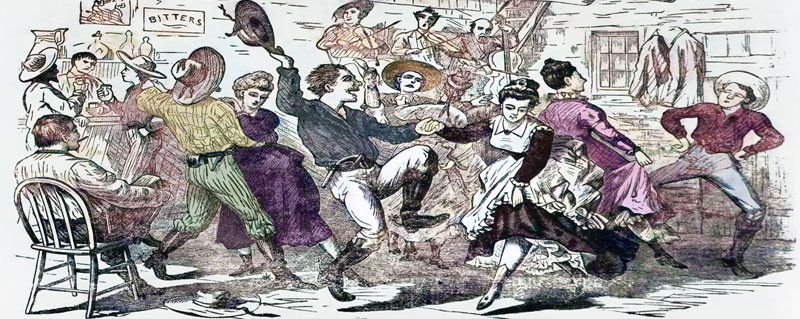
Rowdy dance house.
After the cattle-driving business closed, Wichita’s growth continued as rapidly as before. In 1880, a board of trade was organized with $20,000 capital; the waterworks were installed in 1882, and the street railway the following year. Rapid immigration resulted in a speculative land boom in the late 1880s, stimulating further city expansion. Improvements of all kinds went on very rapidly. New additions were laid out, lots were sold, and houses were built miles from the city’s business section. Fairmount College, which eventually grew into Wichita State University, opened in 1886; Garfield University, which eventually became Friends University, opened in 1887. In 1888, on the occasion of the auction sale of the lots in a new addition, the Wichita Eagle wrote an editorial calling a halt on speculation and telling the people that the time had come to quit buying and selling at inflated values. With that, the boom was over, the city entered an economic recession, and many original settlers went bankrupt. The lots were returned to cow pastures and cornfields, and the city paid for the boom with 15 years of comparative depression.
By 1890, Wichita had become the third-largest city in the state after Kansas City, Kansas, and Topeka, with a population of nearly 24,000.
The Coronado Club, which later became the Wichita Commercial Club, was organized in 1897. The population in 1900 was 24,671. The Chamber of Commerce was organized in 1901.
The city’s manufactured products’ value for 1909 was $9,000,000. Among the important manufacturing concerns were five flour mills with a daily capacity of 4,100 barrels, a broom factory with a daily capacity of 2,000 dozen, two packing plants with an annual production of 60,000,000 pounds, four alfalfa mills, three overall factories, six planing mills using more than 12,000 cars of lumber annually, and six foundries. The city had 230 different manufacturing concerns and 138 wholesale houses, shipping over 50,000 cars of the finished products to its tributary territory. The wholesale and jobbing interests are represented by 500 traveling men who live in the city, and the volume of business in 1909 was $30,000,000.
By 1910, Wichita was one of Kansas’s most important railway centers, directly connecting with almost every city west of the Mississippi River. Five railroads radiated from this point: the Missouri Pacific, Atchison, Topeka & Santa Fe; Chicago, Rock Island & Pacific, St. Louis, and San Francisco; and the Kansas City, Mexico & Orient.
An interurban line connecting Wichita with Wellington, Hutchinson, and other points was constructed. The Kansas City, Mexico & Orient, which has placed Wichita in a position to handle vast shipments from the southwest, was building workshops at this point, adding a new colony to the already cosmopolitan population. New elevated tracks and a union depot were under construction. There was an average of 110 freight and passenger trains per day.
At that time, the Wichita area encompassed an area of about 20 square miles, with 30 miles of paving, 35 miles of street railway, six miles of water mains, 75 miles of sewer, 11 public parks, 100 miles of natural gas mains, 6,500 telephones in use, 16 publishing houses, two daily newspapers (the Beacon and the Eagle), 20 public school buildings, three Catholic academies, two business colleges, an art school, two music conservatories, two colleges ranking with the best in the state — Fairmount College and Friends’ University — 11 banks, good hotels, etc. The amount spent on the building in 1910 was $6,000,000. There were several large office buildings and department stores, six sanitariums, ten theaters, one of the finest Masonic buildings in the country, costing $250,000, a Masonic home and grounds worth a similar amount, a $150,000 Federal building, and a city hall which cost about the same, a chamber of commerce, a commercial club, a fair association which holds one of the largest fairs in the state, a Commercial League, two country clubs, owning fine buildings, all of which are busy promoting the development and best interests of the town.
The building permits for 1910 were three times those of 1908. Among the buildings erected in 1910 was the Beason Building, Kansas’s tallest “skyscraper” at the time. Ten stories high, it cost $380,000 and accommodated 1,000 people. The public and private improvements for 1910 cost $7,000,000. Seven of the eleven banks had been organized since 1902. The value of city property and improvements was more than $3,000,000.
In 1914 and 1915, oil and natural gas deposits were discovered in nearby Butler County. This triggered another economic boom in Wichita as producers established refineries, fueling stations, and headquarters in the city. By 1917, five operating refineries were in Wichita, with another seven built in the 1920s. The careers and fortunes of future oil moguls Archibald Derby, who later founded Derby Oil, and Fred C. Koch, who established what would become Koch Industries, began in Wichita during this period.
The money generated by the oil boom enabled local entrepreneurs to invest in the nascent airplane manufacturing industry. In 1917, Clyde Cessna built his Cessna Comet in Wichita, the first aircraft built in the city. In 1920, two local oilmen invited Chicago aircraft builder Emil “Matty” Laird to manufacture his designs in Wichita, leading to the formation of the Swallow Airplane Company. Two early Swallow employees, Lloyd Stearman and Walter Beech, founded two prominent Wichita-based companies, Stearman Aircraft, in 1926 and Beechcraft in 1932. Cessna, meanwhile, started his own company in Wichita in 1927. The city became such a center of the industry that the Aeronautical Chamber of Commerce dubbed it the “Air Capital of the World” in 1929.
Over the following decades, aviation and aircraft manufacturing continued to drive the city’s expansion. In 1934, Stearman’s Wichita facilities became part of Boeing, which would become the city’s largest employer. The initial construction of Wichita Municipal Airport was finished southeast of the city in 1935. During World War II, the site hosted Wichita Army Airfield and Boeing Airplane Company Plant No. 1. The city experienced a population explosion when it became a major manufacturing center for the Boeing B-29 bomber.
In 1951, the U.S. Air Force announced plans to assume airport control to establish McConnell Air Force Base. By 1954, all nonmilitary air traffic had shifted to the new Wichita Mid-Continent Airport west of the city. In 1962, Lear Jet Corporation opened its plant adjacent to the new airport.
Textron Aviation, Learjet, Airbus, and Boeing/Spirit AeroSystems continue to operate design and manufacturing facilities in Wichita, which remains a significant center of the American aircraft industry. Several airports are located within the city, including McConnell Air Force Base, Colonel James Jabara Airport, and Wichita Dwight D. Eisenhower National Airport, the largest airport in Kansas.
Throughout the late 19th and 20th centuries, several other prominent businesses and brands originated in Wichita. A. A. Hyde founded healthcare products maker Mentholatum in Wichita in 1889. Coleman, a sporting goods and camping gear retailer, started in the city in the early 1900s. Several fast-food franchises started in Wichita, beginning with White Castle in 1921 and followed by many more in the 1950s and 1960s, including Pizza Hut in 1958. In the 1970s and 1980s, the city became a regional healthcare and medical research center.
Except for a slow period in the 1970s, Wichita has continued to grow steadily into the 21st century. In the late 1990s and 2000s, the city government and local organizations began collaborating to redevelop downtown Wichita and older neighborhoods in the city.
Boeing ended its operations in Wichita in 2014. However, the city remains a national aircraft manufacturing center, and other companies, including Spirit AeroSystems and Airbus, maintain facilities in Wichita. Wichita Mid-Continent Airport was officially renamed Wichita Dwight D. Eisenhower National Airport after the Kansas native and U.S. President in 2015.
Wichita’s principal industrial sector is manufacturing. Healthcare is Wichita’s second-largest industry, employing about 28,000 people locally.
As the core of the Wichita metropolitan area, the city is surrounded by suburbs. Bordering Wichita on the north are, from west to east, Valley Center, Park City, Kechi, and Bel Aire. Enclosed within east-central Wichita is Eastborough. Adjacent to the city’s east side is Andover. McConnell Air Force Base is in the extreme southeast corner of the city. To the south, from east to west, lie Derby and Haysville. Goddard and Maize border Wichita to the west and northwest, respectively.
Museums and landmarks devoted to science, culture, and area history are located throughout the city. Several lie along the Arkansas River west of downtown, including the Exploration Place Science and Discovery Center, the Mid-America All-Indian Center, and The Keeper of the Plains statue and its associated display highlighting the daily lives of Plains Indians. The Old Cowtown Living History Museum provides a glimpse of its earlier Old West heydays, depicting life in Wichita from 1865 to 1880. The museum provides 26 historic buildings and reproductions with period interiors, furnishings, machinery, photographs, live animals, and Old West re-enactors.
The Wichita-Sedgwick County Historical Museum in downtown Wichita occupies the original Wichita city hall, which was built in 1892. The museum contains artifacts that tell the story of Wichita and Sedgwick County, starting from 1865 and continuing to the present day. Nearby is the 1913 Sedgwick County Memorial Hall and Soldiers and Sailors Monument. The Museum of World Treasures and the railroad-oriented Great Plains Transportation Museum are east of downtown. The Coleman Factory Outlet and Museum was at 235 N St. Francis Street and was the home of the Coleman Lantern until it closed in 2018. Wichita State University hosts the Lowell D. Holmes Museum of Anthropology. The Kansas Aviation Museum, housed in the Terminal and Administration building of the former Municipal Airport, is in southeast Wichita adjacent to McConnell Air Force Base. The Original Pizza Hut Museum is also located on the Wichita State University campus, which is a place for pizza lovers and fans to visit.
Botanica, The Wichita Gardens, along the Arkansas River, has 24 themed gardens, including the Butterfly Garden and the award-winning Sally Stone Sensory Garden. The Sedgwick County Zoo in the northwest part of Wichita is the most popular outdoor tourist attraction in Kansas and is home to more than 2,500 animals representing 500 species. The zoo is next to Sedgwick County Park and the Sedgwick County Extension Arboretum.
Old Town is located immediately east of downtown, the city’s entertainment district. In the early 1990s, developers transformed it from an old warehouse district into a mixed-zone neighborhood with residential space, nightclubs, restaurants, hotels, and museums.
Three universities have their main campuses in Wichita. The largest is Wichita State University (WSU), a public research university with more than 14,000 students and is the third-largest university in Kansas. WSU’s main campus is in northeast Wichita, with multiple satellite campuses around the metro area. Friends University, a private, non-denominational Christian university, has its main campus in west Wichita, as does Newman University, a private Catholic university. Wichita Area Technical College, founded in 1995, was merged into Wichita State University’s College of Applied Sciences and Technology in 2018 and is now known as WSU Tech.
©Kathy Alexander/Legends of Kansas, updated April 2024.
Also See:
The Chisholm Trail – Herding the Cattle
A Kansas Roadtrip to Old Cowtown Museum (Travel Blog)
Sources:
Blackmar, Frank W.; Kansas: A Cyclopedia of State History, Vol I; Standard Publishing Company, Chicago, IL 1912.
Wichita Chamber of Commerce
Wikipedia

